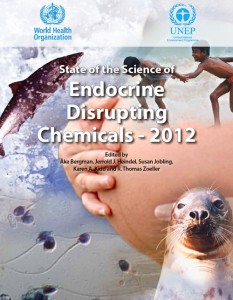 The Impact of Hormone-Disrupting Chemicals
The Impact of Hormone-Disrupting Chemicals
United Nations Environment Programme World Health Organization, February 19, 2013
Many synthetic chemicals, untested for their disrupting effects on the hormone system, could have significant health implications according to the State of the Science of Endocrine Disrupting Chemicals, a new report by the United Nations Environment Programme (UNEP) and World Health Organization (WHO).
The joint study calls for more research to understand fully the associations between endocrine disrupting chemicals (EDCs)—found in many household and industrial products—and specific diseases and disorders. The report notes that with more comprehensive assessments and better testing methods, potential disease risks could be reduced, with substantial savings to public health.
Human health depends on a well-functioning endocrine system to regulate the release of certain hormones that are essential for functions such as metabolism, growth and development, sleep and mood. Some substances known as endocrine disruptors can change the function(s) of this hormonal system increasing the risk of adverse health effects. Some EDCs occur naturally, while synthetic varieties can be found in pesticides, electronics, personal care products and cosmetics. They can also be found as additives or contaminants in food.
The UN study, which is the most comprehensive report on EDCs to date, highlights some associations between exposure to EDCs and health problems including the potential for such chemicals to contribute to the development of non-descended testes in young males, breast cancer in women, prostate cancer in men, developmental effects on the nervous system in children, attention deficit /hyperactivity in children and thyroid cancer.
EDCs can enter the environment mainly through industrial and urban discharges, agricultural run-off and the burning and release of waste. Human exposure can occur via the ingestion of food, dust and water, inhalation of gases and particles in the air, and skin contact.
“Chemical products are increasingly part of modern life and support many national economies, but the unsound management of chemicals challenges the achievement of key development goals, and sustainable development for all,” said UN Under Secretary-General and UNEP Executive Director Achim Steiner. “Investing in new testing methods and research can enhance understanding of the costs of exposure to EDCs, and assist in reducing risks, maximizing benefits and spotlighting more intelligent options and alternatives that reflect a transition to a green economy,” added Steiner.
In addition to chemical exposure, other environmental and non-genetic factors such as age and nutrition could be among the reasons for any observed increases in disease and disorders. But pinpointing exact causes and effects is extremely difficult due to wide gaps in knowledge.
“We urgently need more research to obtain a fuller picture of the health and environment impacts of endocrine disruptors,” said Dr. Maria Neira, WHO’s Director for Public Health and Environment. “The latest science shows that communities across the globe are being exposed to EDCs, and their associated risks. WHO will work with partners to establish research priorities to investigate links to EDCs and human health impacts in order to mitigate the risks. We all have a responsibility to protect future generations.”
The report also raises similar concerns on the impact of EDCs on wildlife. In Alaska in the U.S., exposure to such chemicals may contribute to reproductive defects, infertility and antler malformation in some deer populations. Population declines in species of otters and sea lions may also be partially due to their exposure to diverse mixtures of PCBs, the insecticide DDT, other persistent organic pollutants and metals such as mercury. Meanwhile, bans and restrictions on the use of EDCs have been associated with the recovery of wildlife populations and a reduction in health problems.
The study makes a number of recommendations to improve global knowledge of these chemicals, reduce potential disease risks, and cut related costs. These include:
- Testing: known EDCs are only the ‘tip of the iceberg’ and more comprehensive testing methods are required to identify other possible endocrine disruptors, their sources and routes of exposure.
- Research: more scientific evidence is needed to identify the effects of mixtures of EDCs on humans and wildlife (mainly from industrial by-products) to which humans and wildlife are increasingly exposed.
- Reporting: many sources of EDCs are not known because of insufficient reporting and information on chemicals in products, materials and goods.
- Collaboration: more data sharing between scientists and between countries can fill gaps in data, primarily in developing countries and emerging economies.
“Research has made great strides in the last ten years showing endocrine disruption to be far more extensive and complicated than realized a decade ago,” said Professor Åke Bergman of Stockholm University and Chief Editor of the report.
“As science continues to advance, it is time for both management of endocrine disrupting chemicals and further research on exposure and effects of these chemicals in wildlife and humans.”
Visit EcoWatch’s BIODIVERSITY page for more related news on this topic.

{ 1 comment… read it below or add one }
This may be “gilding the lily” for some readers, but the endocrines are signaling compounds, secreted directly into the blood in very small quantities. The fact they have such small volume means exceedingly small quantities of inhibitors reacting with them effect the message they carry.
There are dozens of endocrines, and they are very hard to study, because of the small volume, diluted in blood, and the relatively slow and long lasting effects. The small volume does not mean they are unimportant, endocrines perform vital functions.